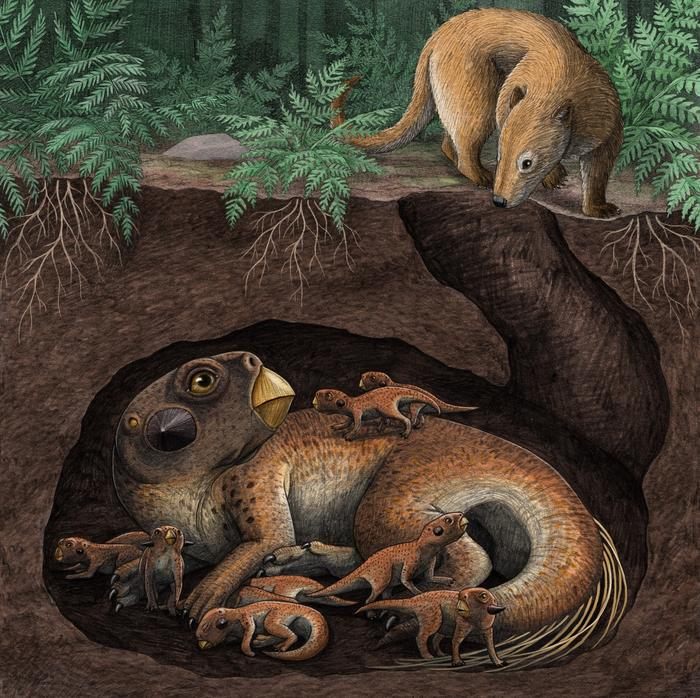An Eruption Like Pompeii Most Likely Didn’t Preserve These Dinosaur Fossils
Posted on Categories Discover Magazine

Some of the most famous and best-preserved dinosaur fossils were thought to have been suspended in time due to a massive volcanic event like the Mt. Vesuvius eruption that literally froze Pompeii in stone.
But the cause of those dinos’ demise was likely much more mundane — collapsing animal burrows, according to a study in the Proceedings of the National Academy of Sciences.
Incredibly Preserved Fossils
Two perfectly articulated skeletons of the sheep-size dinosaur Psittacosaurus, found in China’s Yixian Formation. New research suggests they died in burrow collapses, not via volcanism, as previously thought. (Credit: Jun Liu, Institute of Paleontology and Paleoanthropology, Chinese Academy of Sciences)
A steady stream of fossil discoveries in northeast China in the 1980s triggered a paleontological “Gold Rush” — a “Dino Dash,” if you will. Subsequently, many of the bones discovered in what is now called the Yixian Formation, which contained fossils from between 120 million years and 130 million years ago — were remarkably well preserved. An upper flattened fossil layer even captured some colored feather, which linked how birds and dinos were related. Another layer sometimes captured ancient creatures in 3-D poses that resembled tableaus.
What’s not up for debate is that both layers contained incredibly preserved fossils. “In the upper part of the layers, there were these flattened animals with soft tissues preserved — like eye pigment, feathers, color of hair,” says Paul Olsen, a paleontologist with Columbia University and an author of the study. “It unequivocally showed that non-avian dinosaurs had evolved feathers before flight.”
The deeper layer is equally interesting. In the older strata, the animals were preserved in three dimensions, often in sleeping positions or in nests, or as a guardian of nests, a predator attacking a mammal, or even dinos locked in a fight. The number and variety of these tableaus begged an obvious question.
“How is it possible that these animals are preserved in, in such exquisite detail?” says Olsen.
No Signs of Volcano Destruction
Those scenes of seemingly suspended animation launched speculation that a massive event essentially froze time. But researchers involved in the new study say that two large issues have led to this incorrect conclusion. One involves a scientific “red herring” and the other, flaws in human logic. Both fallacies worked together to lead scientists to an incorrect conclusion. The red herring involves the presence of ash — which seems to indicate that volcanic activity played a role. The logic piece is that when we see something that is amazing, we assume a major event created it.
Because volcanic ash deposits are associated with both upper and lower layers, researchers just assumed there was a causal connection. “You’ve got an extraordinary preservation and then you have evidence of volcanic eruptions,” says Olsen. “Therefore, it must have been something like the catastrophic burial processes at Pompeii.”
However, careful scientific examination has proved both those conjectures wrong. Volcanoes kill in several ways. Rivers of lava burn creatures. A wave of poisonous gas and ashes called pyroclastic flow suffocates, then buries them.
The Yixian Formation shows no sign of either. Hot rivers of lavas would have scorched the soft tissue in the upper layer — including feathers and fur. And the victims of Pompeii adapted what’s called a ‘pugilistic pose’ — a defensive crouch essentially preparing for the death blow. That’s not the case in China. Also, volcanic activity tends to be violent — smashing and scattering objects asunder. Again, that doesn’t appear to have happened in the Yixian Formation fossils.
For the lower 3-D level of fossils, the explanation of cause of death is much more banal: burrow collapse. “In modern animals that burrow, burrow collapse is a really common cause of death,” says Olsen.
For the ancient creatures, collapse could have been triggered by many causes. Earthquakes could cave in an underground home. Flooding could saturate the earth above and around it. A giant sauropod could stomp on it.
Detailed scientific analysis by the study’s lead author, Scott MacLennan of South Africa’s University of the Witwatersrand, also underscored how and why both layers of fossils were so well preserved. He used a relatively new, extremely sensitive method to date both the fossils and the rocks around them. He determined that they hailed from about 125.8 million years ago and were all from a period of around 93,000 years — a “geological eye blink,” says Olsen.
That short geological window is significant because it matches with three periods where variations in the Earth’s orbit triggered relatively wet weather. That would cause sediment to build up and surround fossils faster than previously thought. A quicker burial would cut off the oxygen that aids decomposition. This effect is relevant to both the upper flattened layer as well as the lower 3-D strata, according to Olsen.
He suspects that similar effects may well have happened in other places and times on Earth. We just haven’t found them yet. The rush on the Yixian Formation perhaps over-emphasized a phenomenon that seemed extraordinary, but in fact was probably quite common.
Olsen stresses that understanding how the fossils were preserved doesn’t denigrate them. “This in no way diminishes the importance or spectacular nature of these fossils,” Olsen says.